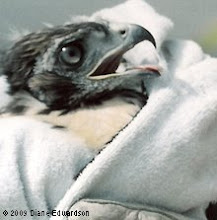 Photo: Diane Edwardson, March 5, 2010. Puncture wounds on the roof rat's back indicate it was most likely killed by a cat. (Click on photo to enlarge.)
Photo: Diane Edwardson, March 5, 2010. Puncture wounds on the roof rat's back indicate it was most likely killed by a cat. (Click on photo to enlarge.)Big ears and eyes, white belly, tail longer than its head and body - UC Davis says this is a roof rat, our most common rat in California hillsides.
Roof or tree rats are more attractive than Norway rats. A neighbor once thought roof rats were baby opossums because they were so cute with big ears and eyes. Nightly, they climbed across the telephone wire from a nearby fruit tree, to the roof and down the porch to get to the dog food bowl, showing no fear of dogs or people. Opossums are a lot larger and generally avoid contact with dogs and people.
When we rescued Red Tail Hawks in 2005 and 2007, a wildlife rehabilitator with the Ojai Raptor Center strongly advised us to tell neighbors NOT to use rat poison to deal with rat problems. When rats or mice ingest poisoned bait, they do not die right away. They desperately seek water and run around erratically, catching the attention of predators. The predator eats the poisoned animal and can die from eating the poisoned rat.
UC Davis Integrated Pest Management Program has a lot of information on rat control.


